YAMAHA YZ85 2016 Owner's Manual
Manufacturer: YAMAHA, Model Year: 2016, Model line: YZ85, Model: YAMAHA YZ85 2016Pages: 88, PDF Size: 2.12 MB
Page 21 of 88

Safety information
2-3
2
ventilated areas. If you experience any
symptoms of carbon monoxide poi-
soning, leave the area immediately, get
fresh air, and SEEK MEDICAL TREAT-
MENT.
Do not run engine indoors. Even if
you try to ventilate engine exhaust
with fans or open windows and
doors, carbon monoxide can rap-
idly reach dangerous levels.
Do not run engine in poorly venti-
lated or partially enclosed areas
such as barns, garages, or car-
ports.
Do not run engine outdoors where
engine exhaust can be drawn into
a building through openings such
as windows and doors.
Genuine Yamaha Accessories
Choosing accessories for your vehicle
is an important decision. Genuine
Yamaha accessories, which are avail- able only from a Yamaha dealer, have
been designed, tested, and approved
by Yamaha for use on your vehicle.
Many companies with no connection
to Yamaha manufacture parts and ac-
cessories or offer other modifications
for Yamaha vehicles. Yamaha is not in
a position to test the products that
these aftermarket companies produce.
Therefore, Yamaha can neither en-
dorse nor recommend the use of ac-
cessories not sold by Yamaha or
modifications not specifically recom-
mended by Yamaha, even if sold and
installed by a Yamaha dealer. Aftermarket Parts, Accessories, an
d
Mo difications
While you may find aftermarket prod-
ucts similar in design and quality to
genuine Yamaha accessories, recog-
nize that some aftermarket accesso-
ries or modifications are not suitable
because of potential safety hazards to
you or others. Installing aftermarket
products or having other modifications
performed to your vehicle that change
any of the vehicle’s design or operation
characteristics can put you and others
at greater risk of serious injury or
death. You are responsible for injuries
related to changes in the vehicle.
Keep the following guidelines in mind,
as well as those provided under “Load-
ing” when mounting accessories. Never install accessories that
would impair the performance of
your motorcycle. Carefully inspect
the accessory before using it to
make sure that it does not in any
way reduce ground clearance or
cornering clearance, limit suspen-
sion travel, steering travel or con-
trol operation.
• Accessories fitted to the han- dlebar or the front fork area can
create instability due to improp-
er weight distribution. If acces-
sories are added to the
handlebar or front fork area,
they must be as lightweight as
possible and should be kept to
a minimum.
• Bulky or large accessories may seriously affect the stability of
the motorcycle. Wind may at-
U1SN84E0.book Page 3 Wednesday, June 10, 2015 10:24 AM
Page 22 of 88

Safety information
2-4
2tempt to lift the motorcycle, or
the motorcycle may become
unstable in cross winds.
• Certain accessories can dis- place the operator from his or
her normal riding position. This
improper position limits the
freedom of movement of the
operator and may limit control
ability, therefore, such accesso-
ries are not recommended.
Use caution when adding electri-
cal accessories. If electrical ac-
cessories exceed the capacity of
the motorcycle’s electrical sys-
tem, an electric failure could re-
sult, which could cause a
dangerous loss of lights or engine
power.
Aftermarket Tires an d Rims
The tires and rims that came with your
motorcycle were designed to match
the performance capabilities and to
provide the best combination of han-
dling, braking, and comfort. Other
tires, rims, sizes, and combinations
may not be appropriate. Refer to page
7-14 for tire specifications and more in-
formation on replacing your tires.
Transportin g the Motorcycle
Be sure to observe following instruc-
tions before transporting the motorcy-
cle in another vehicle. Remove all loose items from the
motorcycle.
Check that the fuel cock (if
equipped) is in the “OFF” position
and that there are no fuel leaks.
Point the front wheel straight
ahead on the trailer or in the truck
bed, and choke it in a rail to pre-
vent movement.
Shift the transmission in gear (for
models with a manual transmis-
sion).
Secure the motorcycle with tie-
downs or suitable straps that are
attached to solid parts of the mo-
torcycle, such as the frame or up-
per front fork triple clamp (and not,
for example, to rubber-mounted
handlebars or turn signals, or
parts that could break). Choose
the location for the straps carefully
so the straps will not rub against
painted surfaces during transport.
The suspension should be com-
pressed somewhat by the tie-
downs, if possible, so that the mo-
torcycle will not bounce exces-
sively during transport.
U1SN84E0.book Page 4 Wednesday, June 10, 2015 10:24 AM
Page 23 of 88
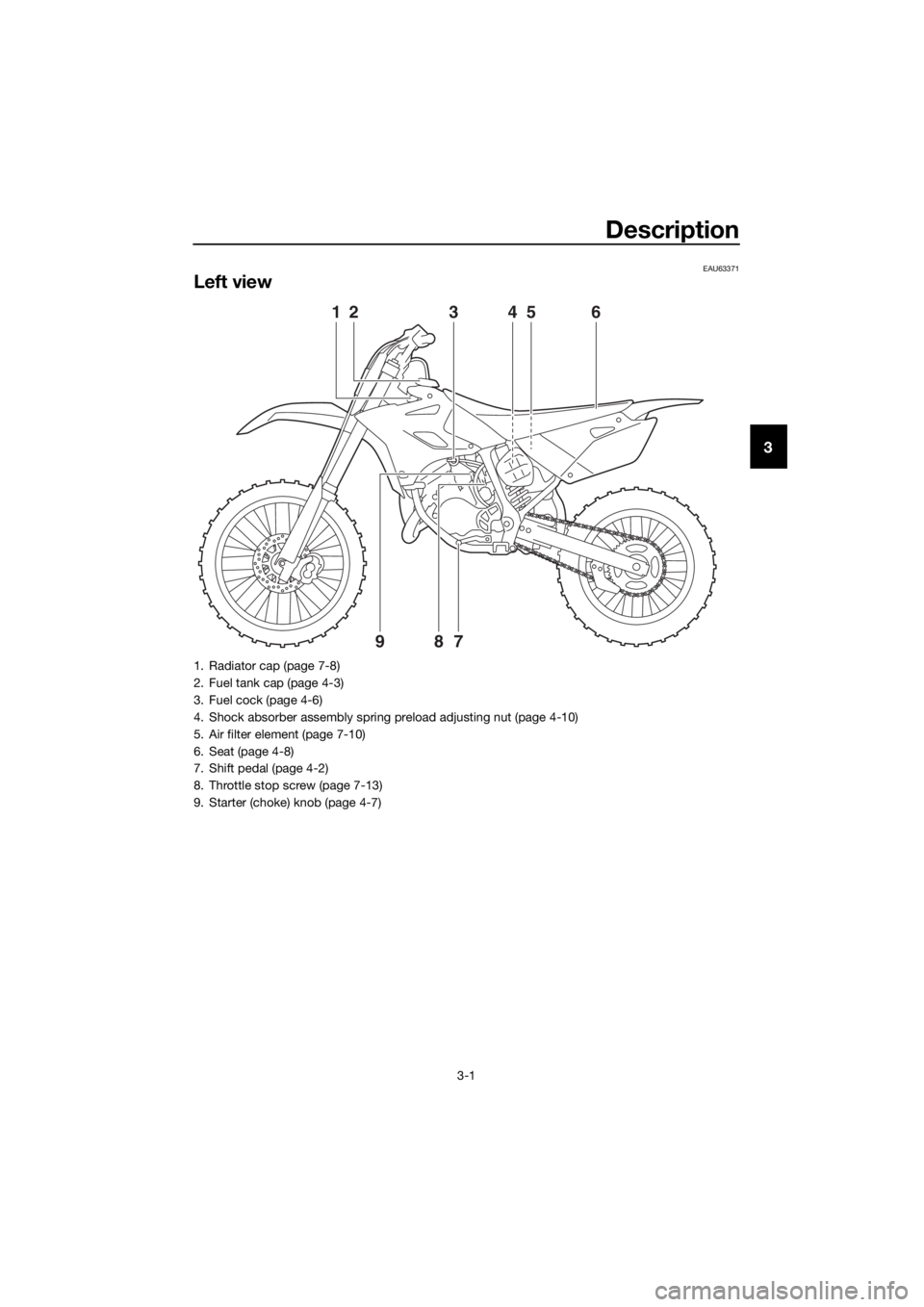
Description
3-1
3
EAU63371
Left view
12789
345 6
1. Radiator cap (page 7-8)
2. Fuel tank cap (page 4-3)
3. Fuel cock (page 4-6)
4. Shock absorber assembly spring preload adjusting nut (page 4-10)
5. Air filter element (page 7-10)
6. Seat (page 4-8)
7. Shift pedal (page 4-2)
8. Throttle stop screw (page 7-13)
9. Starter (choke) knob (page 4-7)
U1SN84E0.book Page 1 Wednesday, June 10, 2015 10:24 AM
Page 24 of 88

Description
3-2
3
EAU63391
Right view
1
9
81011675
2 3,4
1. Shock absorber assembly compression damping force adjusting
screw (page 4-10)
2. Kickstarter (page 4-7)
3. Front fork rebound damping force adjusting screw (page 4-8)
4. Bleed screw (page 4-10)
5. Front fork compression damping force adjusting screw (page 4-8)
6. Spark plug cap (page 7-6)
7. Transmission oil filler cap (page 7-7)
8. Coolant drain bolt (page 7-9)
9. Brake pedal (page 4-3)
10.Transmission oil drain bolt (page 7-7)
11.Shock absorber assembly rebound damping force adjusting screw (page 4-10)
U1SN84E0.book Page 2 Wednesday, June 10, 2015 10:24 AM
Page 25 of 88
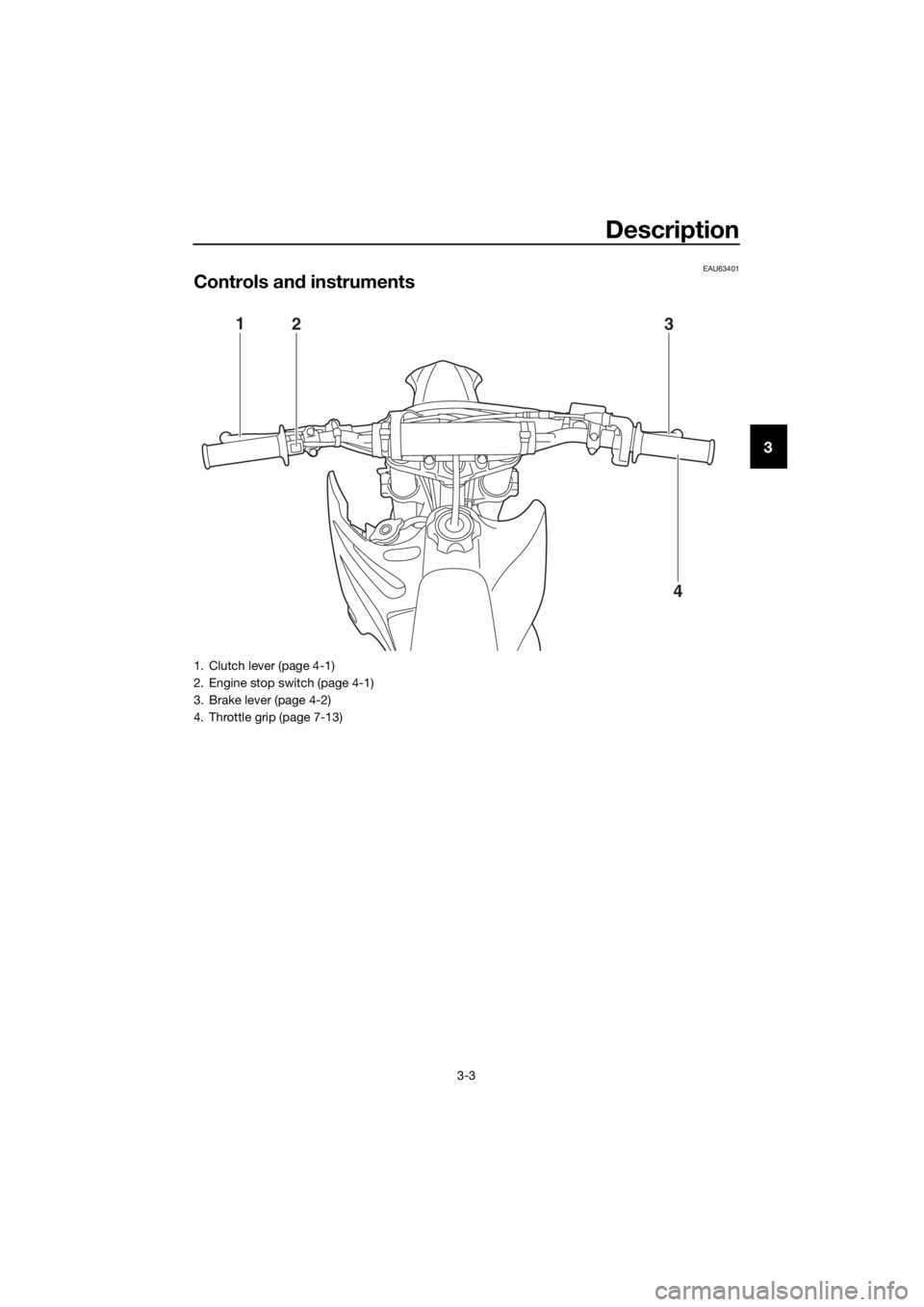
Description
3-3
3
EAU63401
Controls and instruments
4
1
32
1. Clutch lever (page 4-1)
2. Engine stop switch (page 4-1)
3. Brake lever (page 4-2)
4. Throttle grip (page 7-13)
U1SN84E0.book Page 3 Wednesday, June 10, 2015 10:24 AM
Page 26 of 88
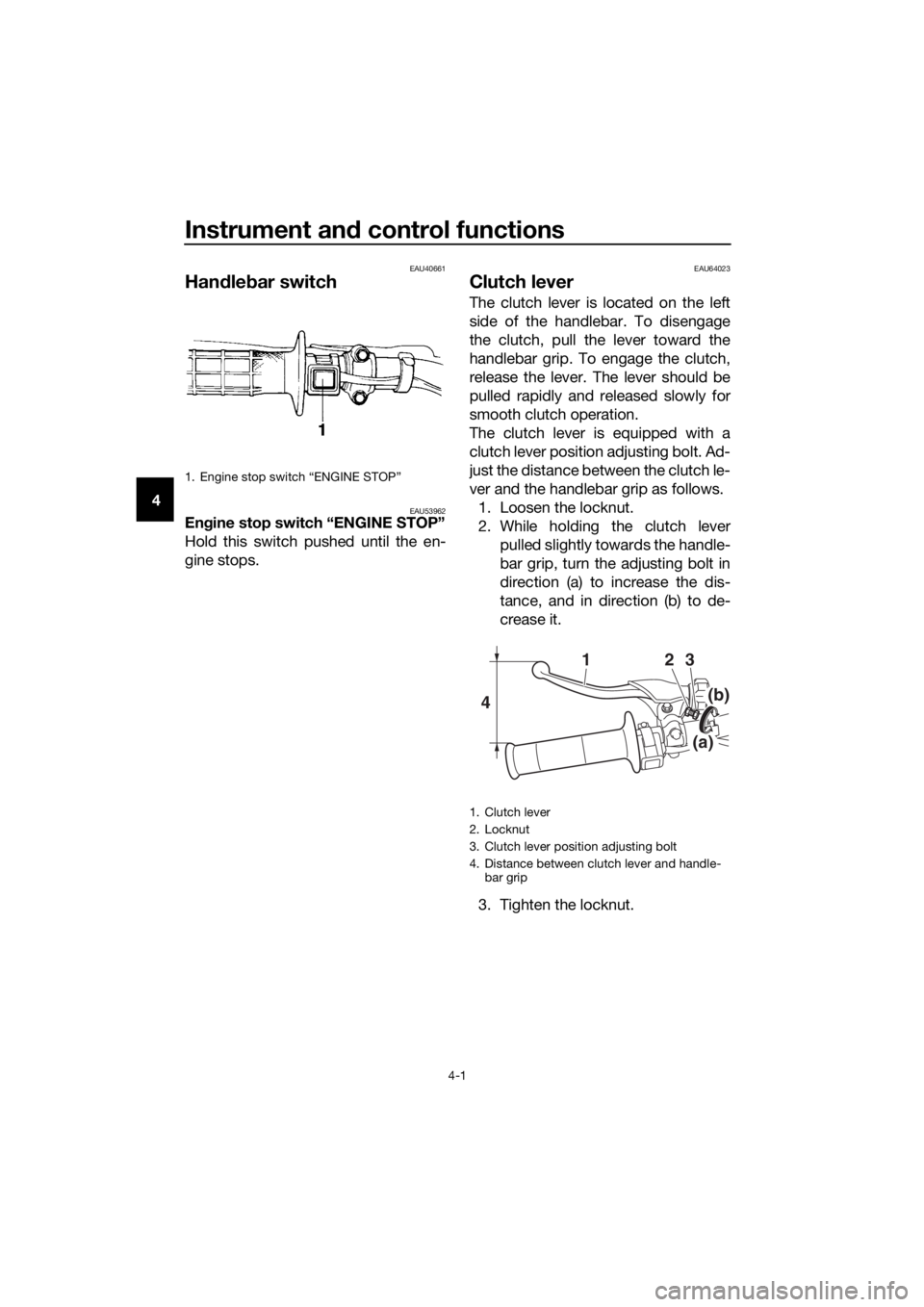
Instrument and control functions
4-1
4
EAU40661
Han dle bar switch
EAU53962En gine stop switch “ENGINE STOP”
Hold this switch pushed until the en-
gine stops.
EAU64023
Clutch lever
The clutch lever is located on the left
side of the handlebar. To disengage
the clutch, pull the lever toward the
handlebar grip. To engage the clutch,
release the lever. The lever should be
pulled rapidly and released slowly for
smooth clutch operation.
The clutch lever is equipped with a
clutch lever position adjusting bolt. Ad-
just the distance between the clutch le-
ver and the handlebar grip as follows. 1. Loosen the locknut.
2. While holding the clutch lever pulled slightly towards the handle-
bar grip, turn the adjusting bolt in
direction (a) to increase the dis-
tance, and in direction (b) to de-
crease it.
3. Tighten the locknut.
1. Engine stop switch “ENGINE STOP”
1. Clutch lever
2. Locknut
3. Clutch lever position adjusting bolt
4. Distance between clutch lever and handle- bar grip
4
213
(b)
(a)
U1SN84E0.book Page 1 Wednesday, June 10, 2015 10:24 AM
Page 27 of 88
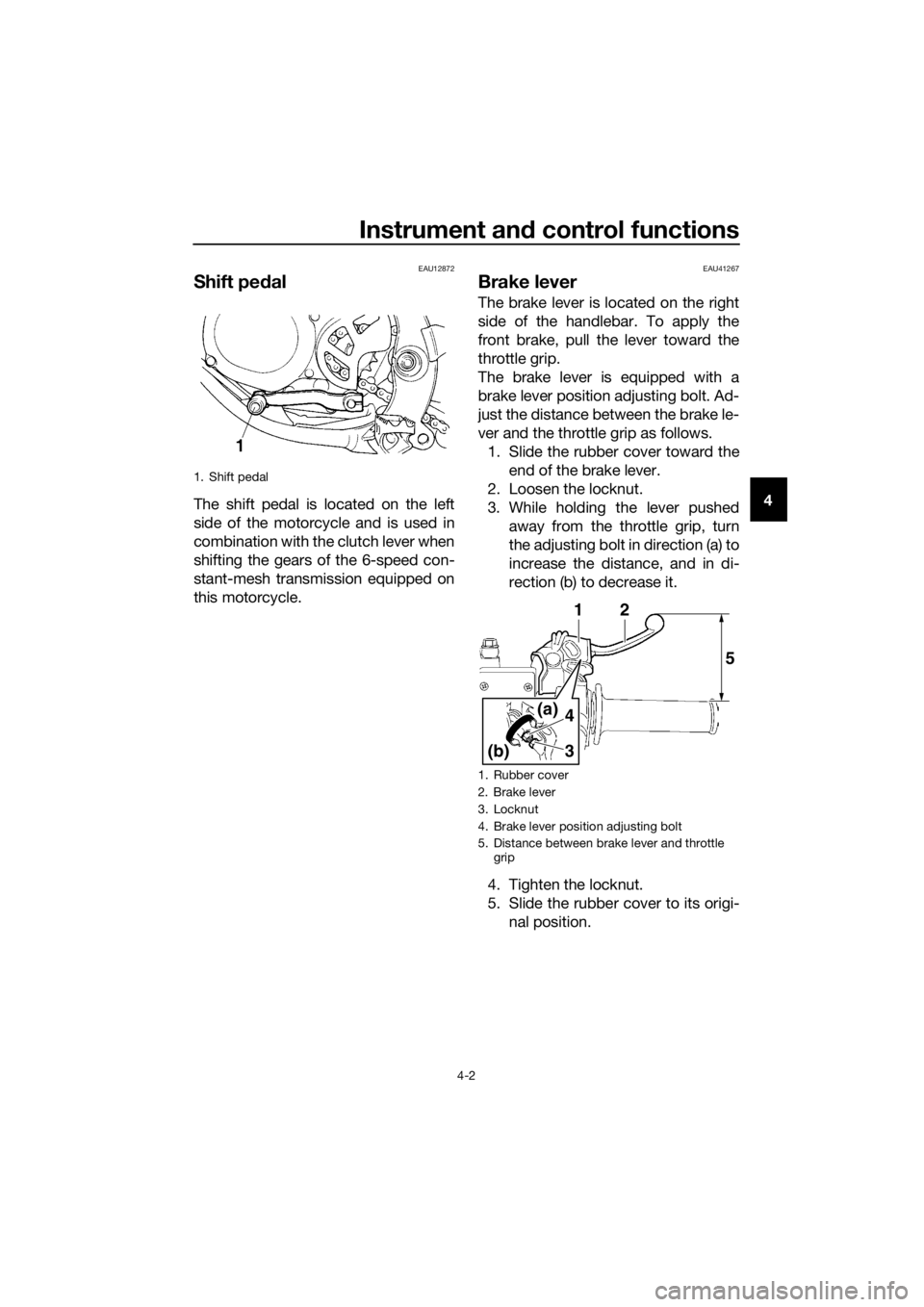
Instrument and control functions
4-2
4
EAU12872
Shift pe dal
The shift pedal is located on the left
side of the motorcycle and is used in
combination with the clutch lever when
shifting the gears of the 6-speed con-
stant-mesh transmission equipped on
this motorcycle.
EAU41267
Brake lever
The brake lever is located on the right
side of the handlebar. To apply the
front brake, pull the lever toward the
throttle grip.
The brake lever is equipped with a
brake lever position adjusting bolt. Ad-
just the distance between the brake le-
ver and the throttle grip as follows.
1. Slide the rubber cover toward the end of the brake lever.
2. Loosen the locknut.
3. While holding the lever pushed away from the throttle grip, turn
the adjusting bolt in direction (a) to
increase the distance, and in di-
rection (b) to decrease it.
4. Tighten the locknut.
5. Slide the rubber cover to its origi- nal position.
1. Shift pedal
1. Rubber cover
2. Brake lever
3. Locknut
4. Brake lever position adjusting bolt
5. Distance between brake lever and throttle grip
1
4
3
(a)
(b)
2
5
U1SN84E0.book Page 2 Wednesday, June 10, 2015 10:24 AM
Page 28 of 88
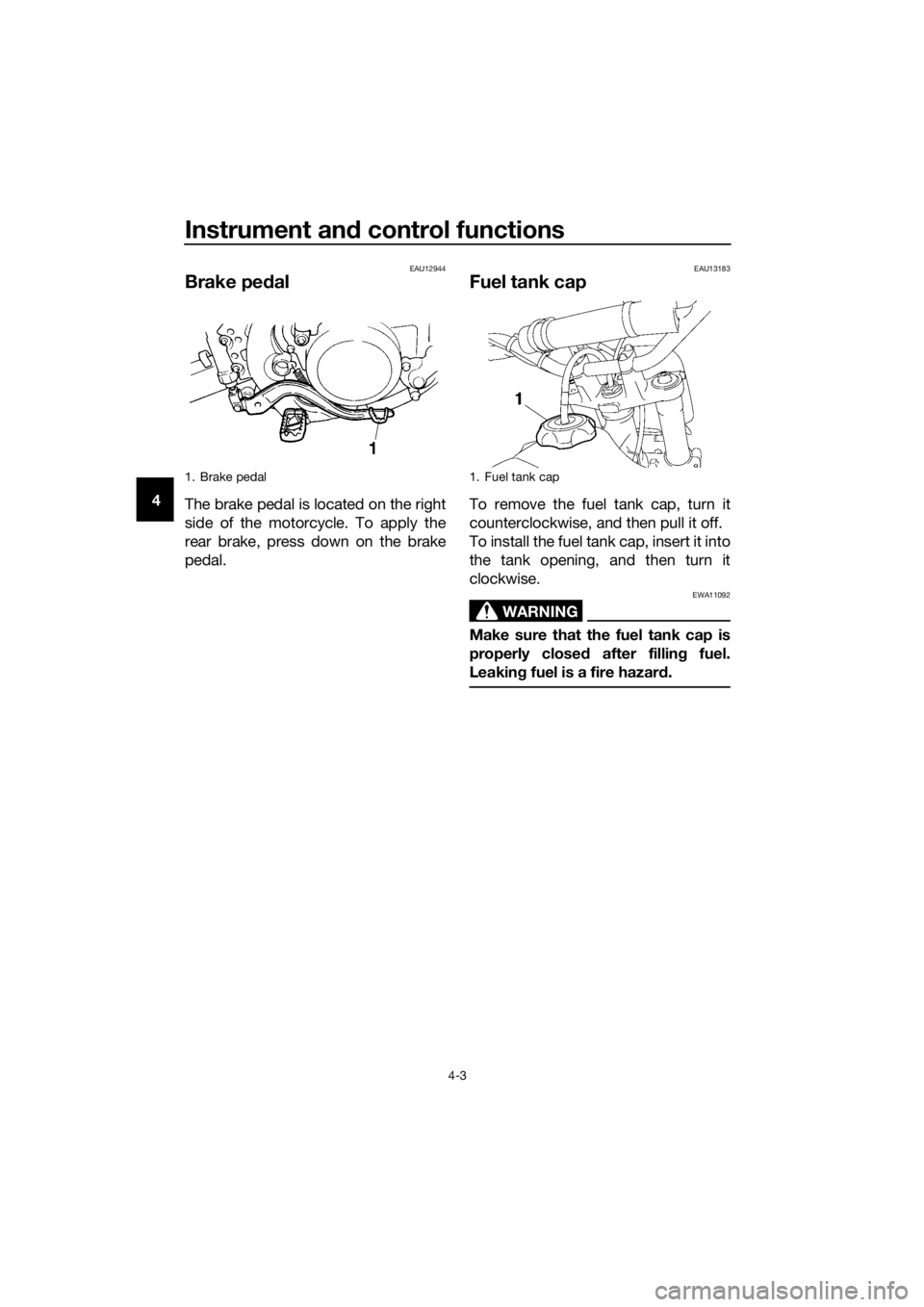
Instrument and control functions
4-3
4
EAU12944
Brake ped al
The brake pedal is located on the right
side of the motorcycle. To apply the
rear brake, press down on the brake
pedal.
EAU13183
Fuel tank cap
To remove the fuel tank cap, turn it
counterclockwise, and then pull it off.
To install the fuel tank cap, insert it into
the tank opening, and then turn it
clockwise.
WARNING
EWA11092
Make sure that the fuel tank cap is
properly close d after fillin g fuel.
Leakin g fuel is a fire hazar d.
1. Brake pedal1. Fuel tank cap
U1SN84E0.book Page 3 Wednesday, June 10, 2015 10:24 AM
Page 29 of 88
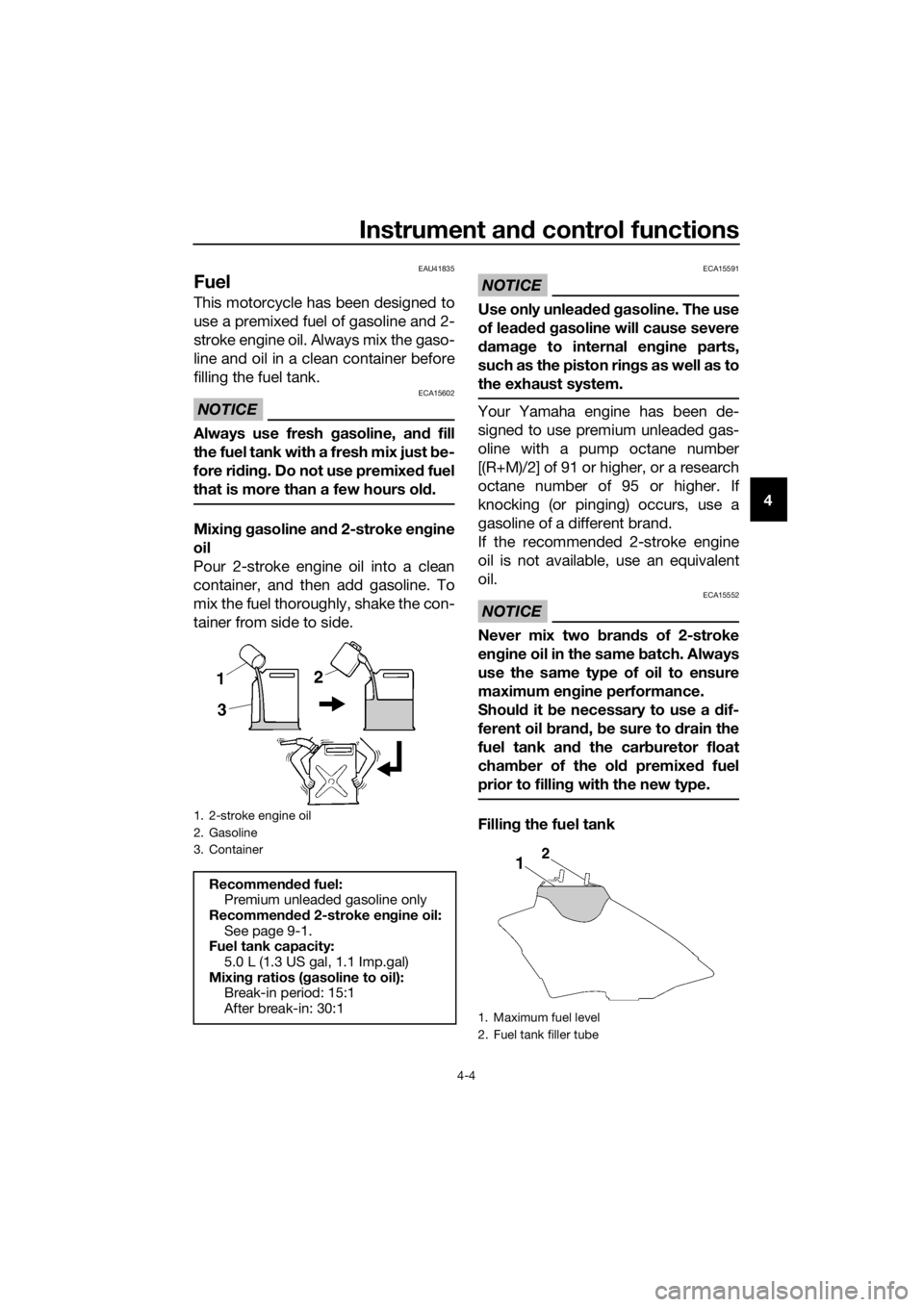
Instrument and control functions
4-4
4
EAU41835
Fuel
This motorcycle has been designed to
use a premixed fuel of gasoline and 2-
stroke engine oil. Always mix the gaso-
line and oil in a clean container before
filling the fuel tank.
NOTICE
ECA15602
Always use fresh g asoline, and fill
the fuel tank with a fresh mix just be-
fore ri din g. Do not use premixe d fuel
that is more than a few hours ol d.
Mixin g g asoline an d 2-stroke en gine
oil
Pour 2-stroke engine oil into a clean
container, and then add gasoline. To
mix the fuel thoroughly, shake the con-
tainer from side to side.
NOTICE
ECA15591
Use only unlea ded g asoline. The use
of lead ed g asoline will cause severe
d amag e to internal en gine parts,
such as the piston rin gs as well as to
the exhaust system.
Your Yamaha engine has been de-
signed to use premium unleaded gas-
oline with a pump octane number
[(R+M)/2] of 91 or higher, or a research
octane number of 95 or higher. If
knocking (or pinging) occurs, use a
gasoline of a different brand.
If the recommended 2-stroke engine
oil is not available, use an equivalent
oil.
NOTICE
ECA15552
Never mix two b rands of 2-stroke
en gine oil in the same b atch. Always
use the same type of oil to ensure
maximum en gine performance.
Shoul d it b e necessary to use a dif-
ferent oil bran d, b e sure to drain the
fuel tank an d the car buretor float
cham ber of the ol d premixe d fuel
prior to fillin g with the new type.
Fillin g the fuel tank1. 2-stroke engine oil
2. Gasoline
3. Container
Recommen ded fuel:
Premium unleaded gasoline only
Recommen ded 2-stroke en gine oil:
See page 9-1.
Fuel tank capacity:
5.0 L (1.3 US gal, 1.1 Imp.gal)
Mixin g ratios ( gasoline to oil):
Break-in period: 15:1
After break-in: 30:1
1. Maximum fuel level
2. Fuel tank filler tube
U1SN84E0.book Page 4 Wednesday, June 10, 2015 10:24 AM
Page 30 of 88
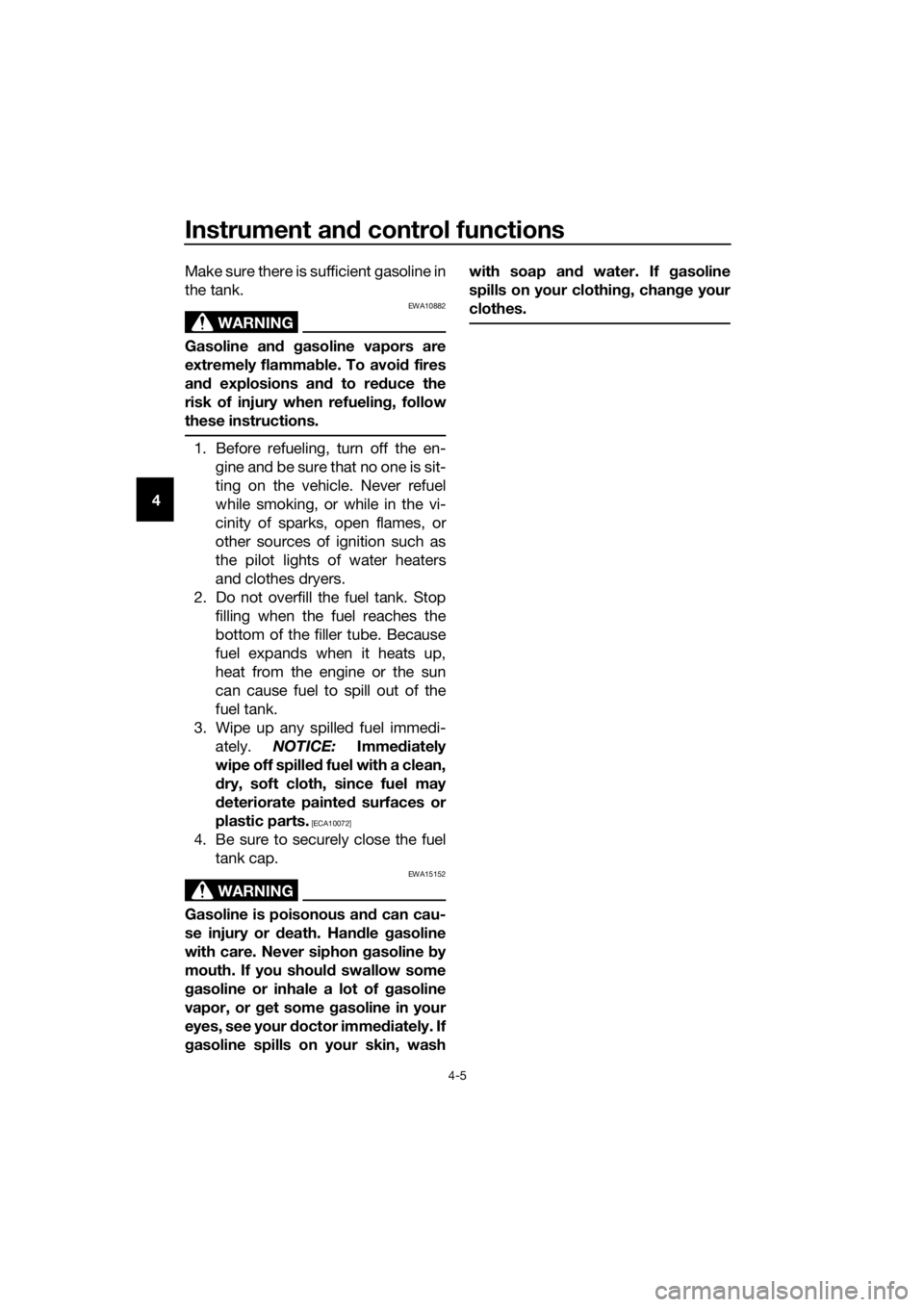
Instrument and control functions
4-5
4 Make sure there is sufficient gasoline in
the tank.
WARNING
EWA10882
Gasoline an
d g asoline vapors are
extremely flamma ble. To avoi d fires
an d explosions an d to re duce the
risk of injury when refuelin g, follow
these instructions.
1. Before refueling, turn off the en- gine and be sure that no one is sit-
ting on the vehicle. Never refuel
while smoking, or while in the vi-
cinity of sparks, open flames, or
other sources of ignition such as
the pilot lights of water heaters
and clothes dryers.
2. Do not overfill the fuel tank. Stop filling when the fuel reaches the
bottom of the filler tube. Because
fuel expands when it heats up,
heat from the engine or the sun
can cause fuel to spill out of the
fuel tank.
3. Wipe up any spilled fuel immedi- ately. NOTICE: Immediately
wipe off spille d fuel with a clean,
d ry, soft cloth, since fuel may
d eteriorate painted surfaces or
plastic parts.
[ECA10072]
4. Be sure to securely close the fuel tank cap.
WARNING
EWA15152
Gasoline is poisonous an d can cau-
se injury or death. Han dle gasoline
with care. Never siphon gasoline by
mouth. If you shoul d swallow some
g asoline or inhale a lot of gasoline
vapor, or g et some gasoline in your
eyes, see your d octor immediately. If
g asoline spills on your skin, wash with soap an
d water. If gasoline
spills on your clothin g, chan ge your
clothes.
U1SN84E0.book Page 5 Wednesday, June 10, 2015 10:24 AM